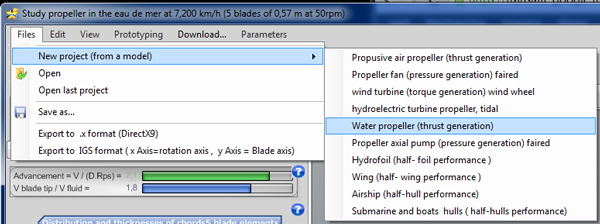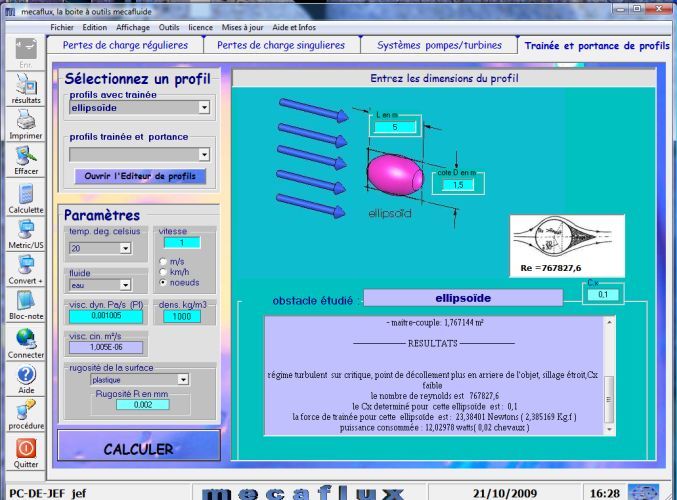Modeling propeller in heliciel software
Tutorial design a boat propeller (1) The specifications of propeller
Understand and master the design a boat screew propeller (1/5):
We will see in this series of five tutorials, how to make a boat propeller with HELICIEL.
In terms of these five tutorials, you will have all the basic knowledge needed for the design of all projects design of marine propellers, but also a mastery of HELICIEL software, and therefore the ability to create air propellers, ventilation, wind turbines, tidal turbines ......Héliciel is used to create a specific propeller following specifications, defining the geometry and evaluating performance. A blade design with its profiles and calibrations can be edited. A 3D model can also be made for prototyping.The propeller designs, uses, multiple skills and years of theoretical and practical experience, but we can do a project independently regardless of our theoretical and mathematical level, and thus take our first steps, or deepen our expertise in achieving a solid efficiency propeller.
- Our project:
The data to be collected before starting the execution of our propeller are:
- the desired thrust..
- cruising speed expected
- available power
- the maximum diameter of our propeller
How to know the resistance to advancement (thus thrust sought) of our boat at cruising speed?We decided at this stage of pre-project, using mecaflux (this software is available on the website mecaflux.com)
- The ideal is to make a full size test , towing the hull And measuring the towing force in a series speeds to the cruise speed expected.
- Data resistance to progress, similar boats will be collected on the net, or in naval literature..
- Testing measures reduced model in Towing tank, and use of "similarity froude" allow to extrapolate to actual sizes
- The resistance of form drag can be extrapolated with a software like mecaflux (method of dual models: take a ellipsoid shape with the length and width of our hull, and it is estimated that the form drag of our hull will be half that of an ellipsoid completely submerged)
Mecaflux is convenient because it also gives the power consumed by the drag.(knowing that we have 300 watts and the efficiency of an engine is 0.8 and the performance of our transmission is 0.8 and the expected performance of our propeller is 0.8,This gives us an overall efficiency of 0.8 * 0.8 * 0.8 = 0.5. We can apply a power to the fluid, 0.5 * 300 = 150 wattsBy entering a cruising speed of 1 knots to 4 knots for a ellipsoid of 5 meters by 1.5 meters, we obtain a series of form drag that we divide by two:
Our 300 watt power available is that of the energy source, estimating the coefficient of efficiency for the engine to 0.8, and the coefficient of performance of the transmission as 0.8 , we have a efficiency from the energy source and the propeller shaft 0.8X0.8 = 0.64. So we can expect a power shaft: 300 watts x 0.64 = 192 watts. We retain this information as basic specifications:We see that the maximum cruise speed with a source of 300W and an overall efficiency of 0.5 will hardly exceed 3 knots. (You can store water skis, it is not today)
- noeud: => 23 Newtons / 2 =11.5 N (power = 12 w / 2= 6 watts)
- noeuds: => 93 Newtons / 2 =41.5 N (power = 96 w / 2= 48 watts)
- noeuds: => 210 Newtons / 2 =105 N (power = 324 w / 2= 162 watts)
- noeuds: => 374 Newtons / 2 =187 N (power = 769 w / 2= 384 watts)
- Cruising speed: 3 knots or 1.55 m / sec
- Thrust required 105 newtons
- Power available to the propeller shaft: 192 watts



 Global site map
Global site map Mecaflux
Mecaflux Tutorials Mecaflux Pro3D
Tutorials Mecaflux Pro3D Tutorials Heliciel
Tutorials Heliciel Mecaflux Store
Mecaflux Store Compare software functions
Compare software functions Quotes, Orders, Payment Methods
Quotes, Orders, Payment Methods project technical studies
project technical studies